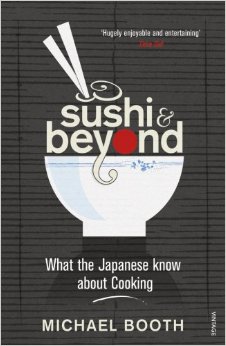Book Review: Sushi and Beyond
July 5, 2015 · 0 comments
By Meghan Ellis.
One man eats Japan. That’s the basic premise of Michael Booth’s book (and, now, anime series) Sushi & Beyond. In fact, it’s called British Family Eats Japan in translation; as far as travel/cookery literature goes, there are few better places to visit if you’re a veteran foodie with a knack for writing. Booth’s three-month, sprawling adventure through the country’s major food hubs is a revelatory experience for both himself and readers, and the resulting series of vignettes is well worth the ride.
His rather provoking opening statement on Japanese cooking is that it’s “all about appearance…[with] no fat, no flavour. All you need to make good Japanese food is a sharp knife and a good fishmonger.” He’s solidly proven wrong, and perhaps the most charming thing about it all, and maybe the reason for the book’s success in Japan, is the gradual way he comes around to the Japanese way of thinking (a relief for his long-suffering friend Toshi). Accompanied by his young family and the wise words of Shizuo Tsuji’s treatise on Japan’s cuisine, Japanese Cooking: A Simple Art, Booth transforms from an ignorant ‘no-brain-whitey-gaijin’ to a man who pines for Sapporo crab and delicate kaiseki dining.
 It’s by no means a complete transformation, as one of the only things that lets the book down is the often-deliberate playing to stereotypes. His “Japan’s a weird place, nudge-nudge, wink-wink” act gets old quickly, and at times he seems to enjoy playing up the gaijin stereotype, awkwardly blundering into wince-provoking situations. Encounters with Japan’s cookery VIPs and his subsequent behaviour gives the impression that he’s being indulged, much in the same way they’d deal with a daft child, but his enthusiasm for their efforts is obviously genuine.
It’s by no means a complete transformation, as one of the only things that lets the book down is the often-deliberate playing to stereotypes. His “Japan’s a weird place, nudge-nudge, wink-wink” act gets old quickly, and at times he seems to enjoy playing up the gaijin stereotype, awkwardly blundering into wince-provoking situations. Encounters with Japan’s cookery VIPs and his subsequent behaviour gives the impression that he’s being indulged, much in the same way they’d deal with a daft child, but his enthusiasm for their efforts is obviously genuine.
And that’s where Sushi & Beyond stands out amongst other culinary tours of the Far East. Once he moves past the comedy, Booth’s reverent talk on the ingredients, their preparation and serving bears the mark of someone who’s both good at cooking food and eating it. His family’s gentle amble through the country is perfectly planned to introduce the staples – the initial chapters talk about the main components of Japanese meals – and then move on to local specialities, the different schools of cooking, and an examination of home- or cheaply-made food versus restaurant fare. From talking to the Ramen Champion, to housewives, to rubbing elbows with Tsuji’s own son, Booth discusses their culinary fields with mouth-watering skill.
While his rhapsodies about the finish on a sashimi slice or the glisten of ramen-grease may lean towards hyperbole, they’re delivered with gusto. And it’s contagious. A particular triumph is the chapters on umami and MSG, as he manages to discuss this man-made glutamic acid and its place in both Eastern and Western dishes in a way that’s informative, inclusive and even humorous. While I won’t be buying manufacturer Ajinomoto’s prepackaged, “raw” MSG any time soon, Booth’s debunking of its evils is an unusual highlight, and something only a trained chef could tackle with such appealing tastiness.
All in all, Sushi & Beyond is a highly educational and entertaining read, whether you’re a cooking buff or an eating aficionado. I’d definitely recommend reading past Booth’s initial reservations and poking fun to get to the good stuff: preferably with food in hand as it’s hungry reading. Whether the anime adaptation (yes, there is an anime version) captures the endearing mix of bumbling Englishman and serious chef on a journey of foodie discovery is left to opinion, but the source material is definitely up to the challenge.
Sushi & Beyond: What the Japanese Know About Cooking is available now from Vintage. The anime version of Sushi and Beyond is currently running on NHK World.

Leave a Reply